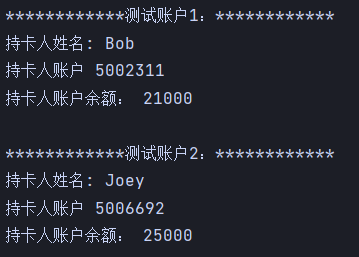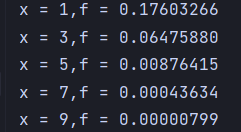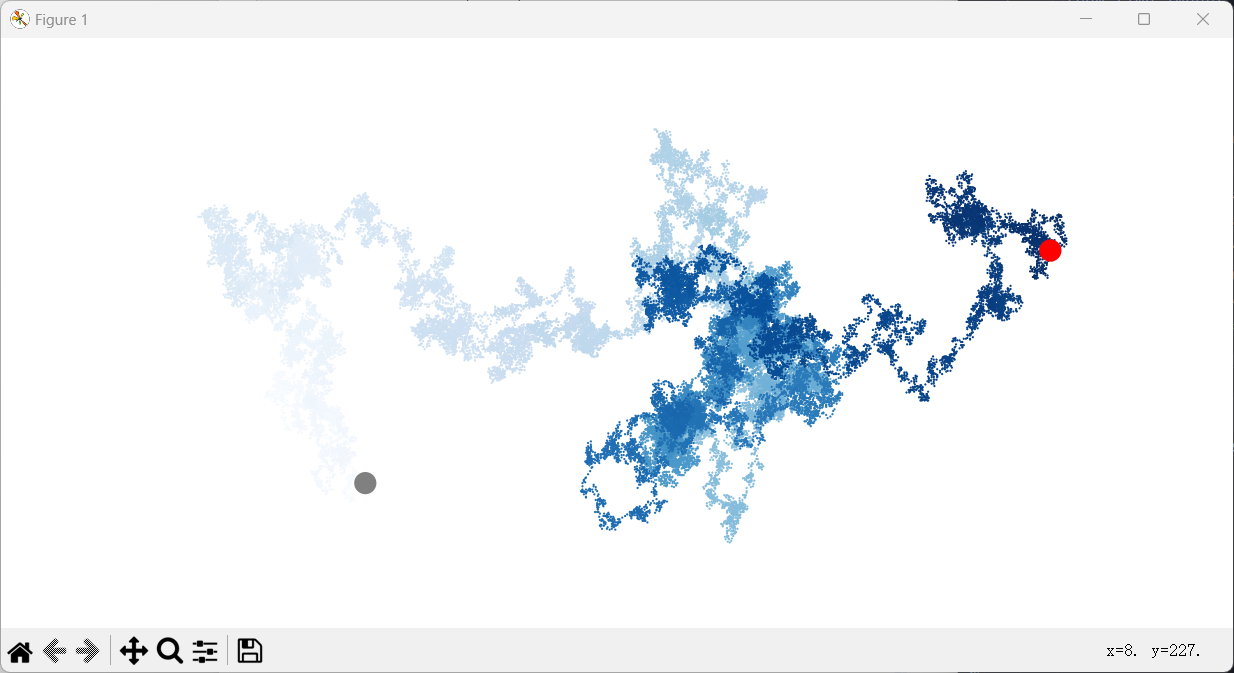实验7 面向对象编程与内置模块
task1
class Account: def __init__(self,name,account_number,initial_amount=10): self._name=name self._card_no=account_number self._balance=initial_amount def deposit(self,account): self._balance+=account def withdraw(self,amount): if self._balance < amount: print('余额不足') return self._balance-=amount def info(self): print('持卡人姓名:',self._name) print('持卡人账户',self._card_no) print('持卡人账户余额:',self._balance) def get_balance(self): return self._balance def main(): print('测试账户1:'.center(30,'*')) a1=Account('Bob','5002311',20000) a1.deposit(5000) a1.withdraw(4000) a1.info() print() print('测试账户2:'.center(30, '*')) a2 = Account('Joey', '5006692', 20000) a2.deposit(10000) a2.withdraw(5000) a2.info() if __name__ == '__main__': main()

1.类:一种模板,内含多种函数。
对象:对象是类的实例。
属性:每个对象都有的属性,例如''name'' 和 ''account_name''。在创建时属性被赋予特殊的值。
方法:类中 使用def定义一个函数,该类有什么具体的行为。
实例化:用类创建一个实例。
2.类的封装性:它指的是将对象的属性和方法封装在一起,并限制外部访问这些属性和方法的方式。
task2
from shape import circle,rect shape_ls=[rect(5,5,10,5),circle(),circle(1,1,10)] for i in shape_ls: i.info() print(f'面积: {i.area(): .2f}') print(f'周长: {i.perimeter(): .2f}') print()
1.类的继承:子类会继承父类的方法和属性。
多态特性:是指具有不同功能的函数可以使用相同的函数名,这样就可以用一个函数名调用不同内容的函数。
2.模块:对代码更高级的封装,包含很多类,函数等,导入模块可避免重复性编写。
task3
from math import * def func(x,m=0,s=2): y=(1/(s*((2*pi)**0.5)))*exp(-0.5*(((x-m)/s)**2)) return y for i in range(1,10,2): print(f'x = {i},f = {func(i):

task4

from random import choice class RandomWalk(): def __init__(self, num_points = 5000): self.num_points = num_points self.x_values = [0] self.y_values = [0] def fill_walk(self): while len(self.x_values) < self.num_points: x_direction = choice([1, -1]) x_distance = choice([0, 1, 2, 3, 4]) x_step = x_direction * x_distance y_direction = choice([1, -1]) y_distance = choice([0, 1, 2, 3, 4]) y_step = y_direction * y_distance # 据绝原地踏步 if x_step == 0 and y_step == 0: continue # 计算下一个点的x和y值 next_x = self.x_values[-1] + x_step next_y = self.y_values[-1] + y_step self.x_values.append(next_x) self.y_values.append(next_y) def main(): rw = RandomWalk(5) rw.fill_walk() print(rw.x_values) print(rw.y_values) if __name__ == '__main__': main()

from matplotlib import pyplot as plt from random_walk import RandomWalk from time import sleep n = 0 while n < 2: n += 1 rw = RandomWalk(50000) rw.fill_walk() plt.figure(figsize = (10, 6), dpi = 128) point_numbers = list(range(rw.num_points)) plt.scatter(rw.x_values, rw.y_values, c=point_numbers,cmap=plt.cm.Blues,edgecolor='none',s=1) plt.scatter(0, 0, c = 'grey', edgecolors='none', s=100) plt.scatter(rw.x_values[-1], rw.y_values[-1],c = 'red',edgecolors='none',s=100) plt.axis('off') plt.show()







 浙公网安备 33010602011771号
浙公网安备 33010602011771号